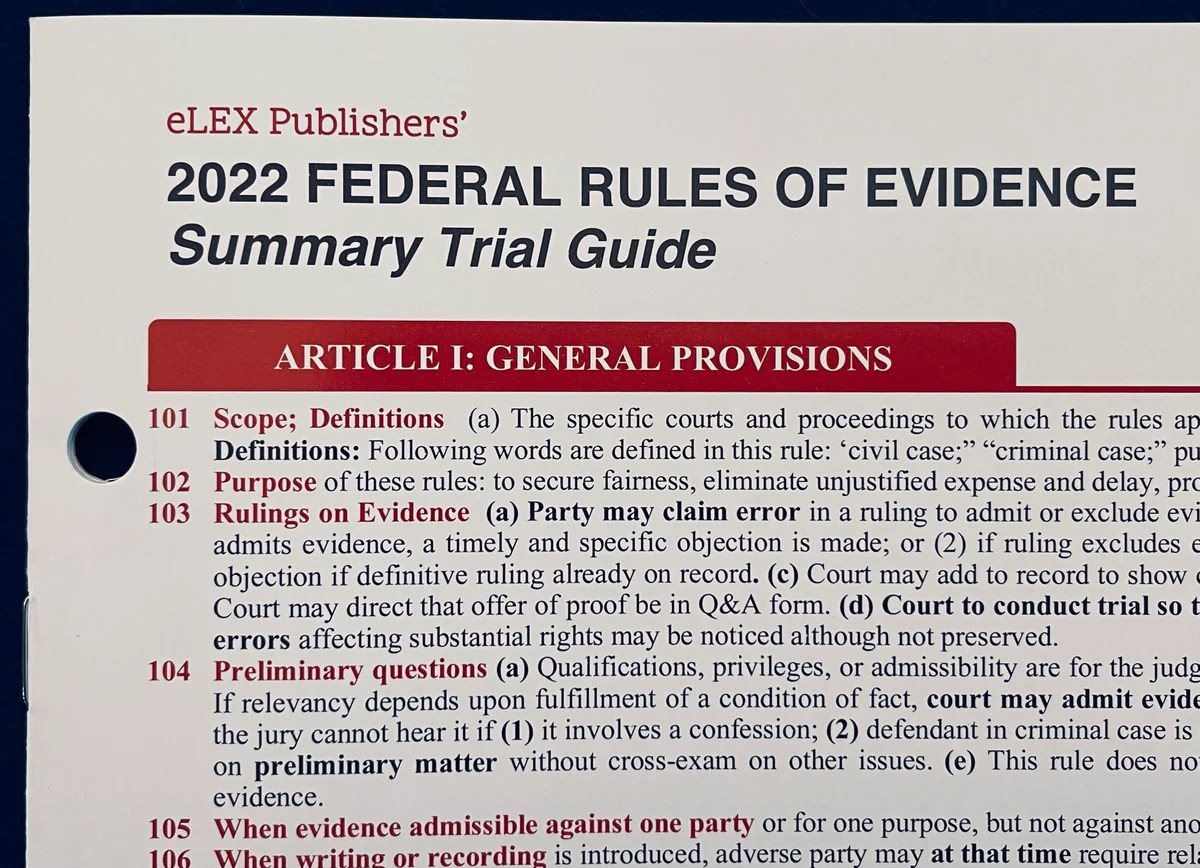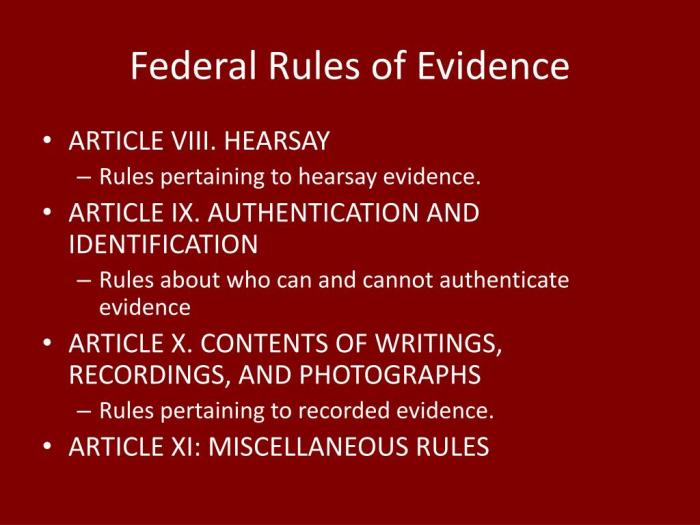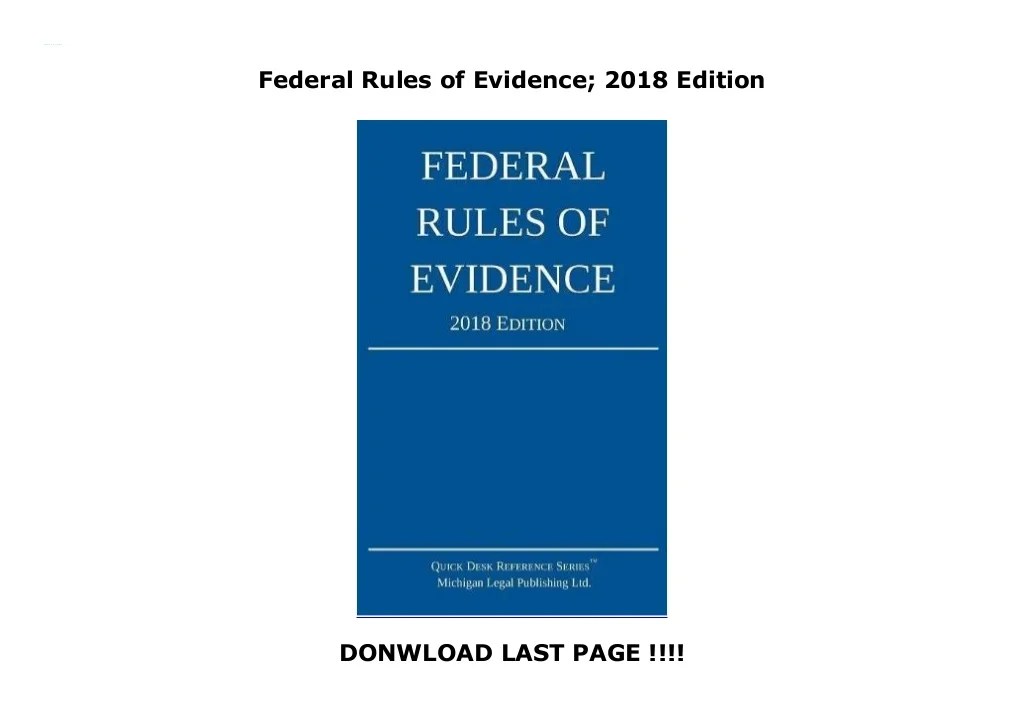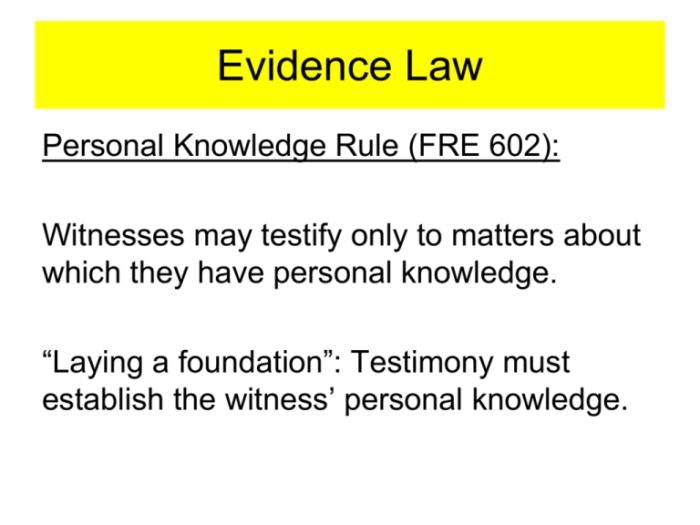Federal rules of evidence flashcards provide an indispensable tool for legal professionals, students, and anyone seeking to understand the intricate framework of evidence admissibility in court. These flashcards offer a convenient and engaging way to grasp the fundamental principles, exceptions, and nuances of the Federal Rules of Evidence (FRE).
Organized according to the structure of the FRE, these flashcards cover a wide range of topics, including relevance, credibility, privilege, expert testimony, character evidence, physical evidence, and the impact of technology on evidence presentation.
Federal Rules of Evidence (FRE) Overview

The Federal Rules of Evidence (FRE) constitute a comprehensive set of regulations governing the admissibility of evidence in federal courts and proceedings. These rules were promulgated by the Supreme Court of the United States pursuant to the Rules Enabling Act of 1934 and took effect on July 1, 1975.
The FRE are designed to ensure the fair and efficient administration of justice by establishing uniform standards for the admission of evidence. They provide a framework for determining the relevance, reliability, and admissibility of various types of evidence, including testimony, documents, physical objects, and expert opinions.
Structure and Organization of the FRE
The FRE are organized into 11 articles, each addressing a specific aspect of evidence law. The articles are as follows:
- General Provisions
- Judicial Notice
- Presumptions
- Relevancy and Its Limits
- Privileges
- Witnesses
- Opinions and Expert Testimony
- Hearsay
- Authentication and Identification
- Contents of Writings, Recordings, and Photographs
- Miscellaneous Rules
Each article is further divided into sections, which provide detailed rules on specific topics. For example, Article IV, Relevancy and Its Limits, includes sections on the relevance of character evidence, habit evidence, and similar acts evidence.
FRE Relevance and Admissibility

Relevance is a cornerstone of evidence law. It ensures that only evidence that has a tendency to make a fact more or less probable is admitted into trial.
Evidence is relevant if it has any tendency to make a fact that is of consequence to the determination of the action more or less probable than it would be without the evidence.
Examples of Relevant Evidence
- In a murder trial, evidence that the defendant had a motive to kill the victim is relevant.
- In a car accident case, evidence that the defendant was speeding is relevant.
- In a contract dispute, evidence that the defendant breached the contract is relevant.
Exceptions to the Rule Against Hearsay
The rule against hearsay generally prohibits the admission of out-of-court statements. However, there are a number of exceptions to this rule, including:
- Excited utterances
- Present sense impressions
- Dying declarations
- Admissions of a party-opponent
- Ancient documents
FRE Credibility and Impeachment
Credibility is the believability of a witness’s testimony. It is an important factor in determining the weight that a jury will give to the testimony. There are a number of factors that can affect a witness’s credibility, including their demeanor, their bias, and their prior convictions.
Impeachment is the process of attacking a witness’s credibility. There are a number of methods that can be used to impeach a witness, including:
Prior Convictions
A witness’s prior convictions can be used to impeach their credibility. The theory behind this rule is that a witness who has been convicted of a crime is less likely to be truthful. However, there are some limitations on the use of prior convictions for impeachment purposes.
For example, a witness’s prior conviction cannot be used to impeach their credibility if the conviction is more than 10 years old.
Bias, Federal rules of evidence flashcards
A witness’s bias can also be used to impeach their credibility. Bias is a prejudice or partiality that can affect a witness’s testimony. There are a number of factors that can create bias, including the witness’s relationship to the parties involved in the case, the witness’s financial interest in the outcome of the case, and the witness’s personal beliefs.
Inconsistent Statements
A witness’s inconsistent statements can also be used to impeach their credibility. Inconsistent statements are statements that are made by a witness that are contradictory to each other. Inconsistent statements can be used to show that a witness is not truthful or that they are not reliable.
FRE Privilege and Confidentiality

The Federal Rules of Evidence (FRE) protect certain communications and relationships from being disclosed in court. These protections are known as privileges and confidentiality.
Privileges are legal rights that allow a person to refuse to disclose information that would otherwise be admissible in court. The FRE recognizes several types of privileges, including the attorney-client privilege, the doctor-patient privilege, and the spousal privilege.
Exceptions to the Attorney-Client Privilege
The attorney-client privilege is one of the most important privileges recognized by the FRE. It protects communications between a lawyer and their client from being disclosed in court. However, there are a number of exceptions to the attorney-client privilege, including:
- The crime-fraud exception: This exception applies when the client is seeking legal advice in order to commit a crime or fraud.
- The joint client exception: This exception applies when two or more clients are represented by the same lawyer and they have a common interest in the communication.
- The waiver exception: This exception applies when the client voluntarily waives the privilege.
FRE Expert Testimony

Expert testimony is admitted when scientific, technical, or other specialized knowledge will assist the trier of fact to understand the evidence or to determine a fact in issue. The expert must be qualified as an expert by knowledge, skill, experience, training, or education.
The expert’s testimony must be based on sufficient facts or data, the testimony must be the product of reliable principles and methods, and the expert must have reliably applied the principles and methods to the facts of the case.
Types of Expert Witnesses
There are many different types of expert witnesses, including:
- Medical experts can testify about medical conditions, injuries, and treatments.
- Engineering experts can testify about the design, construction, and operation of machines and structures.
- Financial experts can testify about accounting, economics, and finance.
- Scientific experts can testify about the natural sciences, such as physics, chemistry, and biology.
Examples of Expert Testimony
Expert testimony can be used in a wide variety of cases, including:
- Medical malpractice cases
- Product liability cases
- Construction defect cases
- Insurance coverage disputes
- Intellectual property disputes
FRE Character Evidence
Character evidence is generally inadmissible in federal courts because it is considered irrelevant and potentially prejudicial. However, there are exceptions to this rule, including:
Character Evidence to Prove Conduct
Character evidence may be admitted to prove conduct in the following situations:
- Character of the accused in a criminal case
- Character of the victim in a criminal case
- Character of a witness
Admissible Character Evidence
Examples of admissible character evidence include:
- Evidence of a person’s reputation for truthfulness or dishonesty
- Evidence of a person’s reputation for violence or peacefulness
- Evidence of a person’s reputation for being a law-abiding citizen
Inadmissible Character Evidence
Examples of inadmissible character evidence include:
- Evidence of a person’s religious beliefs
- Evidence of a person’s political beliefs
- Evidence of a person’s sexual orientation
FRE Physical and Demonstrative Evidence
Physical and demonstrative evidence is a vital component of many legal proceedings, as it can provide jurors with a tangible representation of the facts and circumstances surrounding a case.
Physical evidence refers to any object that is relevant to the case, such as a weapon, a piece of clothing, or a document. Demonstrative evidence, on the other hand, is any object that is used to illustrate or explain other evidence, such as a map, a chart, or a model.
Admissibility of Physical and Demonstrative Evidence
In order to be admissible in court, physical and demonstrative evidence must be relevant to the case and must not be unduly prejudicial or inflammatory. The judge will also consider whether the evidence is authentic and whether it has been properly preserved.
Types of Physical and Demonstrative Evidence
There are many different types of physical and demonstrative evidence that can be used in court, including:
- Documents: Documents can include contracts, letters, emails, and other written materials.
- Objects: Objects can include weapons, clothing, vehicles, and other physical items.
- Photographs: Photographs can be used to depict the scene of a crime or to show the condition of a person or object.
- Videos: Videos can be used to show the events leading up to a crime or to demonstrate how a particular event occurred.
- Charts and graphs: Charts and graphs can be used to illustrate complex data or to show trends.
- Models: Models can be used to represent the scene of a crime or to demonstrate how a particular event occurred.
Use of Physical and Demonstrative Evidence in Court
Physical and demonstrative evidence can be used in court to prove a variety of facts, including:
- Identity: Physical evidence can be used to identify a person or object.
- Intent: Physical evidence can be used to show a person’s intent.
- Cause and effect: Physical evidence can be used to show the cause of an event.
- Damages: Physical evidence can be used to show the extent of damages.
Physical and demonstrative evidence can be a powerful tool in the courtroom, and it can help jurors to understand the facts of a case and to reach a just verdict.
FRE Technology and Evidence: Federal Rules Of Evidence Flashcards
The Federal Rules of Evidence (FRE) have been significantly impacted by the rapid advancements in technology, particularly in the areas of electronic evidence and the use of technology in the presentation and analysis of evidence.
One of the most significant changes brought about by technology is the admissibility of electronic evidence. The FRE now explicitly address the admissibility of electronic evidence, including emails, text messages, social media posts, and other digital data. These rules provide guidance on the authentication and reliability of electronic evidence, ensuring that it is treated fairly and consistently in court.
Authentication of Electronic Evidence
- Electronic evidence must be authenticated to ensure its genuineness and reliability.
- Authentication can be accomplished through various methods, including:
- Witness testimony
- Digital signatures
- Chain of custody
Reliability of Electronic Evidence
- The reliability of electronic evidence is assessed based on factors such as:
- The integrity of the data
- The accuracy of the recording process
- The trustworthiness of the source
Use of Technology in the Presentation and Analysis of Evidence
Technology is also being used to enhance the presentation and analysis of evidence in court. For example, digital projectors and interactive whiteboards allow attorneys to display evidence in a clear and engaging manner. Additionally, computer software can be used to analyze large amounts of data, such as financial records or social media data, to identify patterns and trends that may be relevant to the case.
Question & Answer Hub
What are the Federal Rules of Evidence?
The Federal Rules of Evidence (FRE) are a set of rules that govern the admissibility of evidence in federal courts. They were adopted in 1975 to ensure the fairness and reliability of evidence presented in trials.
What is the purpose of federal rules of evidence flashcards?
Federal rules of evidence flashcards provide a convenient and engaging way to learn and review the FRE. They can be used for self-study, exam preparation, or as a quick reference guide during trial.
What topics are covered by federal rules of evidence flashcards?
Federal rules of evidence flashcards typically cover a wide range of topics, including relevance, credibility, privilege, expert testimony, character evidence, physical evidence, and the impact of technology on evidence presentation.